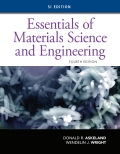
(a)
Interpretation:
The draw force needs to be calculated considering no friction of copper wire.
Concept Introduction:
Cold working is the
Answer to Problem 8.53P
The draw force required for original copper wire is 6096.65 N.
Explanation of Solution
Given Information:
1 inch = 2.54 cm
% cold work is given by the following relation:
Here,
Equation (1) becomes,
Thus at 30.56 % cold work from the graph yield strength of copper = 138 MPa.
Now, drag force (F) is calculated from the following formula,
Here,
Equation (2) becomes,
(b)
Interpretation:
Whether the drawn wire break in the drawing wire or not needs to be determined.
Concept Introduction:
Cold working is the mechanical process in which matrial is plastically deformed under recrystallization temperature.
Answer to Problem 8.53P
The stress after the wire is drawn under cold work is 198.71MPa which is less than actual yield strength 370MP. Hence wire will not break.
Explanation of Solution
Given Information:
1 inch = 2.54 cm
Thus drag force F of wire of copper is 6096.65 N
Final diameter = 0.625 cm
The stress (s) on the wire after cold work is given by the following relation:
Yield strength material will not break.
Want to see more full solutions like this?
Chapter 8 Solutions
Essentials of Materials Science and Engineering, SI Edition
- Q2) Design a Full Adder to add two numbers each of 3 digits.arrow_forwardShow all the workarrow_forwardFor the following MATLAB code, I need to answer a few questions. Can you identify the curves as elliptic functions? Which curves reflect the sn, cn, and dn functions?From the curves, determine the maximum amplitudes and the period corresponding toeach angular velocity component. clc; clear all; I = [500; 125; 425]; w = [0.2; 0.1; 0.2]; rev = 0:0.01:10; C = eye(3); % Using ode45 to integrate the KDE and DDE options = odeset('RelTol',1e-9,'AbsTol',1e-9); result = ode45(@K_DDE, rev, [w; I; C(:)], options); v = result.x; % Extracting information from the ode45 solver w = result.y(1:3, :); C_ode = reshape(result.y(7:end, :), [3,3,length(v)]); plot(v, w) xlabel('rev') ylabel('w (rad/s)') legend('w1', 'w2', 'w3') % Functions function dwCdt = K_DDE(~, w_IC) % Extracting the initial condtions to a variable w = w_IC(1:3); I = w_IC(4:6); C = reshape(w_IC(7:end), [3, 3]); I1 = I(1); I2 = I(2); I3 = I(3); K1 = -(I3-I2)/I1; K2 = -(I1-I3)/I2; K3 = -(I2-I1)/I3; %…arrow_forward
- For the four-bar- linkage shown in the following figure. BC=68mm, CD=100mm, AD=120mm. Determine the range of AB to make it a crank-rocker mechanism. B Darrow_forwardQ1) Design a Multiplexing system (shown below) to transmit six channels each of 10Kbps speed, through single channel with the following channel sequence: ch6, then ch1, then ch5, then ch2, then ch4, then ch3. The available clock is of 120KHz. (hint use jk flip flop in the timing and coding unit). Timing & code generator for the Clock 120KHz requested sequence CO C1 $2 --- $1 38 8 C2 Multiplexer C3 C4 C5arrow_forwardQ3) Compare two numbers (A,B) each of two digits either A>b or Aarrow_forwardall of those 4 fi 1)Draw kinematic diagram: 2)DOF: 3)type/name of mechanism 4)evolution:arrow_forwardManual solution only, no Al usedarrow_forwardLook up the dislocation-induced energy levels in silicon and GaAs - cite your sources. a. Sketch them in the band gap. b. When are each of them most active? c. Are dislocations more detrimental in Si or GaAs? d. What is the threshold of dislocation density that each semiconductor can handle?arrow_forwardarrow_back_iosSEE MORE QUESTIONSarrow_forward_ios
 MATLAB: An Introduction with ApplicationsEngineeringISBN:9781119256830Author:Amos GilatPublisher:John Wiley & Sons Inc
MATLAB: An Introduction with ApplicationsEngineeringISBN:9781119256830Author:Amos GilatPublisher:John Wiley & Sons Inc Essentials Of Materials Science And EngineeringEngineeringISBN:9781337385497Author:WRIGHT, Wendelin J.Publisher:Cengage,
Essentials Of Materials Science And EngineeringEngineeringISBN:9781337385497Author:WRIGHT, Wendelin J.Publisher:Cengage, Industrial Motor ControlEngineeringISBN:9781133691808Author:Stephen HermanPublisher:Cengage Learning
Industrial Motor ControlEngineeringISBN:9781133691808Author:Stephen HermanPublisher:Cengage Learning Basics Of Engineering EconomyEngineeringISBN:9780073376356Author:Leland Blank, Anthony TarquinPublisher:MCGRAW-HILL HIGHER EDUCATION
Basics Of Engineering EconomyEngineeringISBN:9780073376356Author:Leland Blank, Anthony TarquinPublisher:MCGRAW-HILL HIGHER EDUCATION Structural Steel Design (6th Edition)EngineeringISBN:9780134589657Author:Jack C. McCormac, Stephen F. CsernakPublisher:PEARSON
Structural Steel Design (6th Edition)EngineeringISBN:9780134589657Author:Jack C. McCormac, Stephen F. CsernakPublisher:PEARSON Fundamentals of Materials Science and Engineering...EngineeringISBN:9781119175483Author:William D. Callister Jr., David G. RethwischPublisher:WILEY
Fundamentals of Materials Science and Engineering...EngineeringISBN:9781119175483Author:William D. Callister Jr., David G. RethwischPublisher:WILEY





